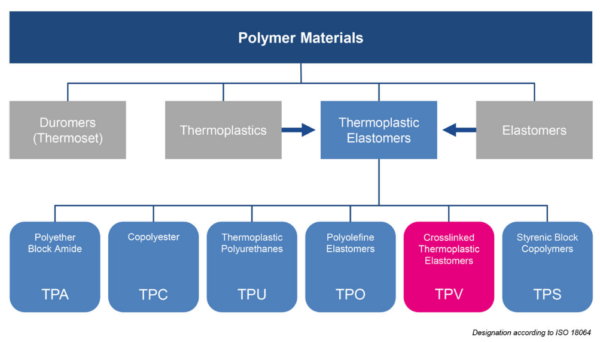Understanding Thermoplastic Elastomers: Versatile and Recyclable

Thermoplastic elastomers (TPEs) are unique materials that combine the elastic properties of rubber with processability.
These polymers exhibit elastic behavior due to thermo-reversible cross-links and phase separation. They can be melted and reshaped like traditional plastics, allowing for efficient recycling. The elastic properties of TPEs stem from the interplay between the crystalline and elastomeric phases. The crystalline phase provides strength and stability, while the elastomer phase offers flexibility and elasticity. The material flows when the crystalline phase melts or dissolves, enabling various processing methods.
You can also read: Kraiburg TPE’s new Thermoplastic Elastomers meet Strict Water-Contact Compliance Rules
Temperature-dependent Behavior
The service temperature range of TPEs depends on the elastomer phase’s glass transition temperature (Tg) and the crystalline phase’s Tg or melting temperature (Tm). At low temperatures, TPEs become stiff and brittle. As the temperature rises, they turn elastic and rubber-like, maintaining a constant modulus until the crystalline phase softens or melts, transforming the material into a viscous fluid.
Synthesis Methods for Thermoplastic Elastomers (TPEs)
Manufacturers use several methods to synthesize TPEs. For instance, they produce block copolymers through anionic, cationic, and controlled living radical polymerization. They prepare thermoplastic vulcanizates (TPVs), another type of TPE, via dynamic vulcanization. This process involves mixing elastomers with thermoplastics, followed by cross-linking. Other methods include esterification, polycondensation, transesterification, catalytic copolymerization, and direct copolymerization.
Also, there are different types of TPEs:

TPE’s classification based on Thermoplastic elastomers — Nomenclature and abbreviated terms ISO18064:2022. Courtesy of Kraiburg TPE’s.
Importance of Phase Separation

Thermoplastic elastomers’ unique properties make them ideal for various industrial applications.
Effective phase separation is essential for superior mechanical properties in TPEs. This phase separation occurs when the free energy of mixing is positive. Factors favoring phase separation include high molecular weight segments, significant structural differences, and low temperatures. The classification of TPEs includes seven main groups: styrenic block copolymers, crystalline multi-block copolymers, TPVs, miscellaneous block copolymers, semi-crystalline polymer/elastomer combinations, graft copolymers, and ionomers. Most TPEs are block or graft copolymers characterized by sequences of different chemical and physical structures.
Advantages of TPEs
TPEs offer numerous advantages over conventional rubber materials. They require simpler processing with fewer steps and shorter fabrication times, lowering production cost. Manufacturers typically supply TPEs fully formulated, eliminating the need for compounding. Additionally, TPEs are reusable, reducing waste and lowering energy consumption.
However, TPEs also have disadvantages. They melt at elevated temperatures, limiting their use in high-temperature applications. Manufacturers offer a limited availability of low hardness TPEs, and processing requires prior drying. Despite these challenges, TPEs remain a versatile and recyclable alternative to traditional rubber materials. Their unique properties make them ideal for various industrial applications, offering a sustainable solution for the future.
To read the complete book chapter Specialty Thermoplastics.
